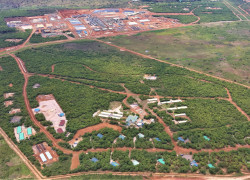From healing to growing: Quintet unveils midyear investment outlook
“Counterpoint” highlights bullish view on global economy and equity markets, despite near-term inflation concerns and expected higher volatility.
Led by the United States, global economic growth will remain strong for the remainder of the year, with much of the world returning to pre-pandemic activity levels by the end of 2021. Policymakers will continue to support economic activity and employment, including by pursuing inflationary policies – which will lead to higher asset prices even as the current consumer-price inflation spike proves temporary.
That is the view of Bill Street and Daniele Antonucci, Chief Investment Officer and Chief Economist, respectively, at Quintet Private Bank, which today released its midyear Counterpoint featuring five calls on the global economy, financial markets and key asset classes:
1. RUNNING ON HIGH PRESSURE
The global economy is finally transitioning to the other side of the pandemic, notes Antonucci. Following China, the US and the UK, reopening is also now taking place in some of the “laggard” regions, such as Europe, where vaccine rollouts are accelerating and restrictions are finally being more substantially eased. While not as robust as in the US, given lower fiscal stimulus, Europe’s recovery is underway.
More broadly, ongoing reopening and government stimulus will drive a strong rebound in economic activity, says Antonucci, who sees limited risk of overheating and expects the pace of growth to begin to normalize once activity reaches pre-pandemic levels. “At that point,” he said, “economic conditions should remain solid, as policymakers continue to stimulate, supporting a self-sustained growth path.”
For investors, cyclical rotation will continue to prove effective while the economy remains in the reopening phase, according to Street. Investors should continue to seek exposure to growth and fiscal stimulus, as well as global trade, infrastructure spending and industrial activity. Equity markets remain promising, he said, adding that global, US and UK small-cap stocks all currently hold appeal.
Street believes that emerging-market equities could remain under pressure, however, while private markets and multi-strategies should continue to serve as return-enhancers. “Investment-grade credit and, selectively, high yield may have relatively limited upside in the near term, while some commodities linked to decarbonization appear well supported over the longer term,” he said.
2. THE INFLATION HEAD FAKE
Markets are today focused on near-term inflation risks, linked to rising oil prices and transient supply bottlenecks. Given that wage growth is still subdued and that, over the long term, technological innovation and aging populations will continue act as disinflationary forces, Antonucci believes the current inflation spike is unlikely to be sustained. “We expect a subsequent inflation slowdown and, globally, believe the rate of price increases will remain below central bank targets over the next few years,” he said.
From an investment perspective, Street says that the continued focus on near-term inflation risks will contribute to high levels of volatility in fixed-income markets. It may also affect long-duration assets, including technology stocks, from time to time. “We may see gyrations in longer-term inflation expectations and a potential bid for real assets, including equities, private markets and inflation-linked bonds, as well as inflation hedges such as gold and commodities,” said Street.
3. STEEPER FOR LONGER
As economic activity eventually shifts to mid-cycle, says Antonucci, central banks will refrain from hiking rates and support affordable government funding of large-scale stimulus programs. “Given record-high levels of indebtedness,” he said, “central banks have no choice other than keep policy rates very low to allow cheap government funding and fiscal stimulus.”
“As the cycle moves from its very early stage to a slightly more mature one, yield curves typically flatten, as central bank rate hikes approach,” explained Street. “This time around, however, we expect steep curves for longer, which should benefit selected banks and financials across equity and credit, but could remain a drag for some emerging markets across asset classes.”
4. THE POWER OF WORDS
Unexpected events, such as new virus variants, could derail the recovery. But the main risk, according to Antonucci, is too much of a good thing: Stronger-than-expected growth and a potentially more protracted period of inflation could lead to repricing in the bond market, flattening yield curves as investors test central bank resolve to refrain from hiking. “Expect to see alternating periods of rising bond yields and risk asset outperformance,” he said. “Plenty of volatility likely lies ahead.”
The epicenter of any increase in volatility is likely to be the rates market, according to Street, who says that could affect riskier assets via a higher discount factor. This would also mean periods of dollar strength – especially against low-yielding currencies such as the euro and to some extent the yen and Swiss franc – alternating with periods of moderate dollar weakness. “We expect sterling to appreciate slightly as the UK economy rebounds more strongly than most of its peers and adjusts to the post-Brexit world,” he added.
5. BACK TO THE FUTURE
COVID-19 dramatically accelerated the global shift to digital. It fueled breakthrough innovation – not just in technology but also in science and medicine – along with booming capital expenditure on research & development and the extraordinarily rapid adoption of new technologies.
“The telephone took 40 years to achieve 40% adoption, the cell phone achieved that level of market penetration in 20 years, and the smartphone did so in just 10,” said Antonucci. “Now think of web-based video conferencing tools like Zoom, Teams and Skype, which saw widespread adoption almost literally overnight. The gap between early adoption and mass consumption has never been as slim.”
From an investment perspective, Street points out that in the current early-cycle phase, long-duration/growth stocks, such as technology, may be negatively impacted by a slightly higher discount factor. “The horizon that matters is a longer one, however. Investors should consider the deeper structural changes playing out over many years,” he said. “It is through these parameters that investors should think about technological disruption and the long-term opportunities it represents.”
Quintet’s Midyear 2021 Counterpoint is available at: www.quintet.com/en-gb/counterpoint-market-views
Communiqués liés
RSA launches technology and management liability insurance s...
RSA Luxembourg, part of Intact Insurance Specialty Solutions, today announces th...
Lancement d'une nouvelle connexion intermodale entre Bettemb...
CFL multimodal a le plaisir d'annoncer le lancement de sa nouvelle connexion i...
Experts from LUNEX award first micro-credentials in Rwanda o...
The Rwanda Ministry of Education (MINEDUC) formally inaugurated Syllabi, a publi...
ERG Notes that ENRC Secures Landmark Victory as Court of App...
Eurasian Resources Group (ERG), a leading diversified natural resources group he...
LetzToken et La Vie est Belle annoncent leur partenariat ouv...
«?LetzToken?», plateforme de tokenisation pionnière basée à Luxembourg, et ...
ERG announces a Pre-Export Finance Facility Agreement based ...
Eurasian Resources Group (“ERG”, “The Group”), a leading diversified nat...
Il n'y a aucun résultat pour votre recherche







